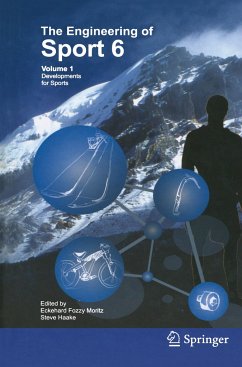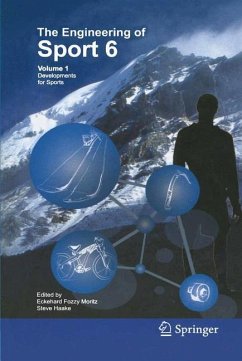
Routledge Handbook of Sports Technology and Engineering
Versandkostenfrei!
Versandfertig in 6-10 Tagen
218,99 €
inkl. MwSt.
Weitere Ausgaben:

PAYBACK Punkte
109 °P sammeln!
Since the 1990s, the field of sports technology and engineering has expanded beyond an initial focus on sports equipment and materials to include various topics. These topics span sustainable equipment design and manufacturing, user centred design, biomechanics and human equipment interaction, field testing, sensors and instrumentation of sports equipment and clothing, smart textiles, artificial intelligence and big data, and the development of human body surrogates for testing protective equipment. This second edition of Routledge Handbook of Sports Technology and Engineering pulls together t...
Since the 1990s, the field of sports technology and engineering has expanded beyond an initial focus on sports equipment and materials to include various topics. These topics span sustainable equipment design and manufacturing, user centred design, biomechanics and human equipment interaction, field testing, sensors and instrumentation of sports equipment and clothing, smart textiles, artificial intelligence and big data, and the development of human body surrogates for testing protective equipment. This second edition of Routledge Handbook of Sports Technology and Engineering pulls together the full depth and breadth of this field, explores current issues and controversies, and looks to future research directions. Bringing together many of the world's leading experts and scientists, this book emphasises the current understanding of the underlying mechanics associated with sport and physical activity, exercise, training, and athletic performance in relation to sports equipment, clothing, and training and officiating technologies in a broad sense.
This book has five sections:
Sports mechanics
Sports materials
Sports equipment design and manufacture
Sports biomechanics and human equipment interaction
Field testing, sensors, and instrumentation
Written by an international team of leading experts, the emphasis throughout this book is on bridging the gap between scientific research and application within sports products and their effect on training and competition. This text is important reading for students, scholars, and others with an interest in engineering related to sport, exercise, and health in general.
This book has five sections:
Sports mechanics
Sports materials
Sports equipment design and manufacture
Sports biomechanics and human equipment interaction
Field testing, sensors, and instrumentation
Written by an international team of leading experts, the emphasis throughout this book is on bridging the gap between scientific research and application within sports products and their effect on training and competition. This text is important reading for students, scholars, and others with an interest in engineering related to sport, exercise, and health in general.













